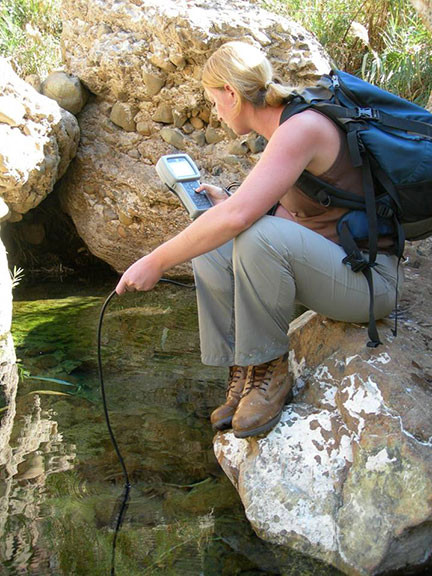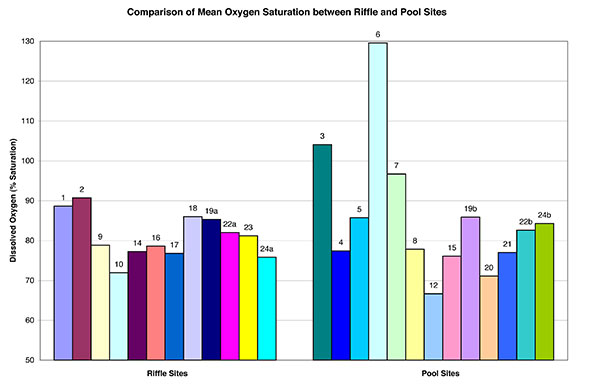Project to Save Rare Freshwater Species
A bid to save some of the Middle East’s rare freshwater fish and their valuable habitat was the focus of Project Wadi Fish. 
In the absence of rivers and lakes, wadi are the primary freshwater habitats in an extremely dry region of the world.
Little is known about them other than they’re under increasing threat from development, urbanization, and pollution. The water forming most wadi pools in the United Arab Emirates is mainly derived from run-off during infrequent rains.
In Wadi Wurrayah, the presence of a spring results in extensive, permanent freshwater bodies with continuous flow. The water flows underground along sections, surfacing periodically in the wadi bed.
Steep slopes and surrounding land influence water movement and storage so that water gathers in the wadi bed.
Project Wadi Fish, the first conservation research project of its kind in the UAE, aimed to map the ecological and conservation status of the freshwater environments of the United Arab Emirates and Oman. Freshwater habitats have suffered the most intense intervention of all ecosystems over the past 100 years.
It is estimated that more than 20 percent of the world’s 10,000 recorded freshwater fish species have become extinct, threatened, or endangered in recent decades. More species and habitats have been lost from freshwater than other ecosystems on land or in the oceans. Wadi Fish project manager, Emma Smart, believes we need to act now to conserve what is left.
“Wadis provide a vital source of water for a wide variety of mammals and birds as well as supporting their own, highly adapted aquatic communities: fish, amphibians, reptiles, and insects,” Smart says. “Virtually nothing is known about wadi fish, what they are eating, when and how they are reproducing, and the adaptations that enable them to survive in such a dry, desert region.”
She cautions, “We should be striving to learn all we can about a natural resource which, in the coming years, could be more valuable than oil.”
Project Focus
The project involved extensive field surveys and expeditions to examine habitat and species distribution. Water quality measurements in several areas were accomplished using a YSI Model 556 (now the ProDSS) handheld multiparameter instrument to look at annual changes to the habitat and the effect these environmental fluctuations may have on the wadi inhabitants.
The initial phase of the Wadi Survey examined both abiotic and biotic factors of wadi freshwater habitats. Both physical and chemical parameters of the water and habitat are part of the study. Phase two will build on the data collected in phase one by examining ecological aspects of the aquatic habitats and looking at the wadi ecosystem as a whole.
The four primary methods of data collection included:
- aquatic habitat distribution
- physical measurements of aquatic habitats
- chemical measurements of aquatic habitats and
- biological measurements of aquatic habitats.
Chemical measurements included dissolved oxygen, pH, conductivity, oxidation reduction potential (ORP), and salinity among other parameters. The YSI instrument was used to measure these parameters and the data stored in the instrument’s memory and subsequently downloaded to a computer for data analysis.
These parameters are not only used for long-term trending analysis of water quality but also used to compare aquatic habitat distribution, such as various types of riffles, rainwater pools, plunge pools, and static boulder pools. The chart below shows the difference in mean oxygen saturation between riffles and pools at several different locations.

The level of oxygen in these habitats is crucial to the type of aquatic life that can survive - if any. Comparatively little is known about freshwater fishes of the UAE. There are just sixteen native species of primary freshwater fishes found throughout the entire Arabian Peninsula. Two of these species are found in the Eastern and Southern parts of the UAE and in Northern Oman. Garra barreimiae is the only native primary freshwater fish species found in the Northern Hajar Mountains.
“This information will give us the chance to make decision-makers aware of conservation priorities,” explained Smart, who coordinated the project as part of her Ph.D. research.
Protection of Freshwater Habitats
Results of the research will be applied to aquatic and ecosystem conservation at a local level through a variety of environmental awareness campaigns in schools, public places, and mosques. Emphasis will be placed on basic, day-to-day ways of protecting wadi habitats, also highlighting the value of the local environment as a tourist attraction and potential source of income, now and in the future. Local undergraduate students from Universities in UAE and Oman were involved in the field data collection to ensure scientific recognition at a local level and also encourage Conservation Biology as a choice for further education.
The establishment of Wadi Wurrayah as a protected area is vital for the future preservation of this unique and biodiverse ecosystem. Wadi ecosystems are increasingly threatened throughout the Arabian Peninsula and in a region of relatively low biodiversity and scarce natural water, should be considered one of the region’s environmental priorities according to Smart.
This survey constitutes the first important step towards the conservation of the area. The baseline data collected and knowledge gained about the ecosystem will form the basis for informed decision-making. In order to make future decisions on the protection of wadi habitats and the conservation of species, it is essential that relevant government departments, as well as non-governmental environmental organizations, have full access to a detailed database on the findings of the research. Comprehensive knowledge of the wadis and their hydrology and ecology will enable decision-makers to identify conservation priorities both locally and regionally.

Additional Blog Posts of Interest:
A Breakthrough in Multiparameter Water Quality Sampling and Profiling
YSI Calibration Solutions and Buffers Expiration Times
Watershed Partnership Addresses Concerns in a Rural Watershed
Monitoring the Effects of a Forest Invader with a Water Quality Meter